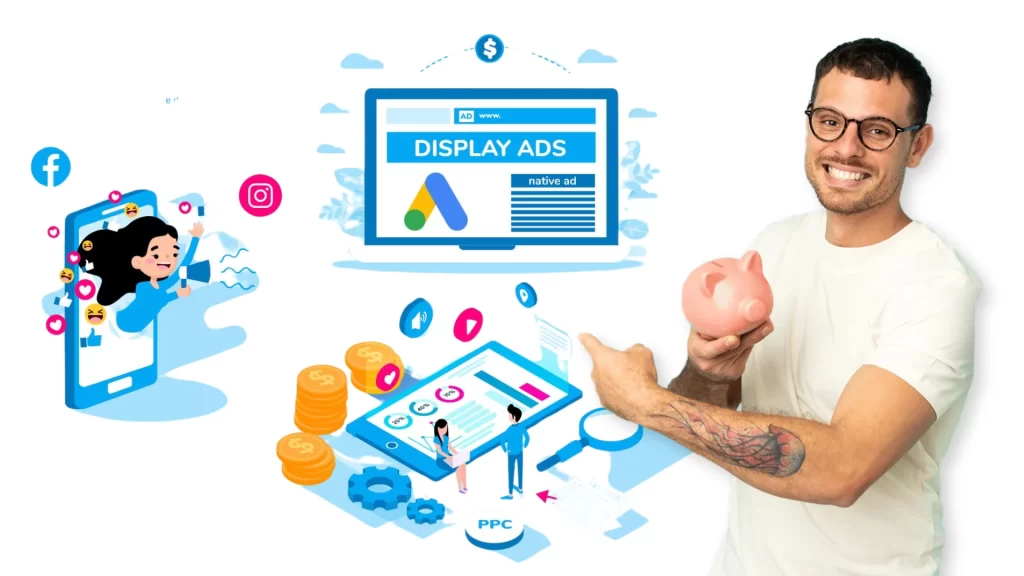Are Your Digital Ads Costing More Than You Think?
Running digital ads in India seems easy. Just launch a campaign, set a budget, and expect sales to roll in. But are you really getting value for your money?
Many businesses unknowingly waste lakhs of rupees on Google ad costs, social media ads, and other digital marketing services—without seeing enough returns. The engagement rate is low, the click-through rate is high, but actual sales? Disappointing.
What’s worse, there are hidden charges businesses don’t even realize they’re paying:
- Ad platform fees that eat into the budget.
- Wasted ad spend on fake clicks from bots and competitors.
- Higher CPC (Cost Per Click) fees if the targeting is wrong.
- Bounce rates on landing pages, meaning visitors leave without buying.
These costs don’t show up clearly, but they silently drain your ad budget. Marketing ads should drive sales, yet they often just consume more money.
But what if there was a smarter way? A way to run effective ads across multiple platforms without wasting money? A solution exists, one that helps businesses cut these hidden costs in Digital Advertising and get better results. But before we get to that, let’s first understand why digital advertising is not as easy as it seems.

1. The Illusion of “Easy” Digital Advertising
Most business owners believe digital advertising is straightforward. Just put money into Google ads or social media ads, and customers will come. That’s what big platforms promise. But the reality is quite different.
Many businesses in India unknowingly lose money due to the hidden costs of digital advertising, which are not always obvious but significantly impact budgets. Here’s how:
- Rising CPC (Cost Per Click): Big companies bid aggressively, increasing ad costs for everyone.
- Fake Clicks & Bot Traffic: Many ad clicks come from bots, not real buyers. You still pay for them.
- Poor Targeting Wastes Money: Ads reach the wrong people, leading to low engagement rates and fewer conversions.
- Hidden Charges from Platforms: Extra fees, commissions, and automatic budget increases take away profits.
- Landing Page Issues: Even when people click, they leave without buying if the page isn’t optimized.
Many businesses try hiring a marketing agency, but even they struggle with managing budget ads effectively. Programmatic advertising and multi-platform campaigns require expertise, and without the right tools, money keeps getting wasted.
So, what’s the way forward? What if your digital marketing ads could automatically adjust to remove fake clicks, reduce ad waste, and improve engagement rates? That’s where smart programmatic advertising is changing the game.
2. The Hidden Costs Businesses Overlook
Many businesses believe that increasing their digital ad budget will automatically bring more customers. But without a solid ad strategy, they unknowingly waste money on hidden costs of digital advertising. These costs don’t appear directly but drain budgets over time. Here are some key areas where businesses lose money:
a) The Cost of Poor Targeting
Most businesses set up Google ads, social media ads, or other marketing ads without detailed targeting. They assume that reaching more people will bring more sales. But here’s the reality:
- Too broad targeting means your ad shows up for people who will never buy.
- Too narrow targeting means you miss out on potential customers.
- The wrong funnel stage leads to wasted ad spend. Showing sales ads to people who are just exploring makes them ignore your brand.
What happens? Your click-through rate (CTR) drops, and you keep paying for clicks that never convert. Your budget ads look like they’re performing well, but the target audience isn’t right, so there’s no return on investment.
b) Ad Fatigue & Banner Blindness
When businesses keep running the same ad creative again and again, people stop noticing it. This is called ad fatigue. Platforms like Facebook, Instagram, and YouTube show your ad too often, and users start ignoring it.
How does this hurt?
- Your CTR drops, meaning fewer people engage with your ad.
- You pay for more impressions, but conversions don’t increase.
- The platform charges higher Google ad costs because your engagement rate is low.
Without fresh content and better ad strategy, businesses burn money on ads that no one even sees.
c) Fraudulent & Invalid Traffic (Wasted Impressions)
Not all clicks are from real people. Many digital marketing campaigns lose money because of fake clicks from bots and competitors. Here’s how this impacts businesses:
- Bots and click farms inflate ad costs without generating real leads.
- Your click-per-rate (CPC) increases because of non-human traffic.
- You think your ad is working, but the numbers are misleading.
Most businesses don’t even realize they are paying for fake engagement. Ad platforms don’t refund this money, meaning your budget is getting wasted without any return.
d) The Algorithm Trap: Increasing Costs Over Time
Businesses often rely on Google ads, Facebook, or Instagram for marketing. But these platforms operate on an auction system, meaning the more businesses bid, the more CPC (cost per click) and CPM (cost per thousand impressions) increase.
Why does this happen?
- More advertisers = more competition = higher ad costs.
- If you don’t optimize your bids, you pay more for the same audience.
- Your marketing ads become more expensive, but results don’t improve.
Without real-time programmatic advertising adjustments, businesses keep increasing budgets while the actual return stays the same—or even drops.
e) The Cost of Multi-Platform Complexity
Running ads on Google, Meta, OTT, CTV, and other platforms without a unified system is exhausting and expensive. Managing different dashboards, tracking performance manually, and trying to align messaging costs time and money.
How does this impact businesses?
- Duplicate ad spending on the same audience across platforms.
- Operational costs increase, as managing multiple campaigns is resource-heavy.
- Inefficiency in performance tracking leads to bad decisions and wasted budgets.
Many businesses don’t even realize they are paying for overlapping audiences or spending more on manual management than necessary.
3. Why Traditional Digital Advertising Fails Businesses
Many businesses follow the same digital marketing playbook—launch ads, set a budget, and expect results. But here’s the problem: traditional digital advertising is broken. Businesses waste money because they rely on outdated methods that don’t work in today’s competitive market.
a) Following “Best Practices” Without a Strategy
Most businesses follow general marketing ads advice without customizing it for their audience. The common mistakes?
- Using broad audience settings in Google ads and social media ads without refining them.
- Running budget ads without A/B testing, leading to poor performance.
- Copying competitors’ strategies without knowing if they are profitable.
A one-size-fits-all ad strategy rarely works. Without personalization, businesses spend money on clicks that don’t convert into sales.
b) Poor Performance Tracking & Attribution
Traditional digital advertising methods don’t track where your money is going. Businesses struggle to measure real engagement rates, and many don’t know:
- Which platform is bringing the highest ROI.
- How much of their Google ad cost is wasted on non-buyers.
- Whether they are overspending on click-through rates (CTR) without conversions.
Without proper tracking, businesses keep increasing budgets blindly—hoping something will work.
c) Misallocated Budgets Across Channels
Many businesses run ads on multiple platforms but don’t know how to distribute their budget correctly. This results in:
- Overspending on low-performing ads and underspending on effective ones.
- Wasting money on ads that overlap, targeting the same audience multiple times.
- Poor coordination between Google ads, OTT, CTV, and social media ads, leading to disjointed messaging.
Without a holistic ad strategy, businesses waste lakhs of rupees without maximizing their results.
4. The Future of Digital Advertising: Smarter, Not Harder
Businesses that continue using outdated digital marketing methods will keep burning cash without real results. The future is about precision-driven, omnichannel advertising, where every rupee is optimized to eliminate hidden costs of digital advertising and maximize returns.
a) Automation & AI-Driven Optimization
Instead of manually adjusting click-per-rate (CPC) and guessing which ads work, AI-powered ad systems are making marketing smarter. Benefits include:
- Real-time ad adjustments to prevent wasted spend.
- Automated audience targeting that ensures ads reach real buyers, not just random users.
- Better engagement rates by predicting which ads will perform best.
Businesses that adopt automation will see higher efficiency and lower costs in their ad campaigns.
b) Omnichannel Advertising for Better Results
Rather than relying only on Google ads or social media ads, businesses are shifting to a unified ad strategy across platforms like:
- OTT & CTV ads to reach premium audiences.
- Audio & video ads for higher engagement.
- Programmatic advertising to automate bidding and targeting for the best ROI.
With smart advertising, businesses don’t waste money on irrelevant clicks and fake impressions. Instead, every rupee works harder to bring actual customers.
Conclusion: Are You Ready to Stop Wasting Money?
Businesses unknowingly spend lakhs on hidden costs of digital advertising, from fraudulent clicks to bad targeting and inefficient budgets. Traditional marketing ads are no longer enough—they lead to wasted money and unpredictable results.
The future of digital marketing is data-driven, automated, and precise. Instead of relying on trial-and-error ad strategies, businesses need solutions that ensure every ad rupee delivers measurable returns.
So the question is: Will you keep burning money on outdated ad methods, or will you embrace a smarter way to advertise?










